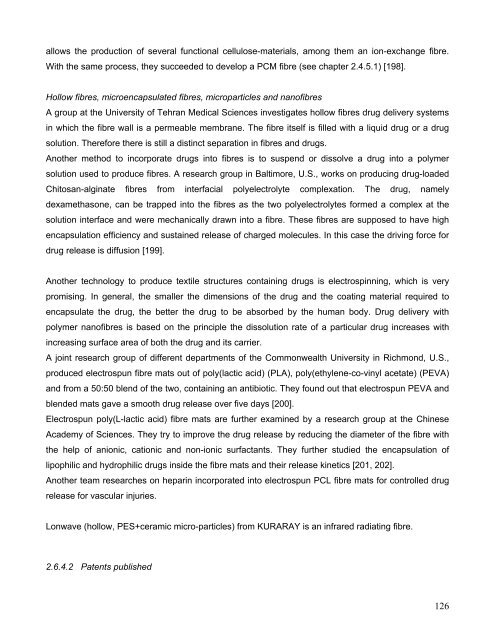Clevertex - Grado Zero Espace Srl
Clevertex - Grado Zero Espace Srl
Clevertex - Grado Zero Espace Srl
Create successful ePaper yourself
Turn your PDF publications into a flip-book with our unique Google optimized e-Paper software.
allows the production of several functional cellulose-materials, among them an ion-exchange fibre.<br />
With the same process, they succeeded to develop a PCM fibre (see chapter 2.4.5.1) [198].<br />
Hollow fibres, microencapsulated fibres, microparticles and nanofibres<br />
A group at the University of Tehran Medical Sciences investigates hollow fibres drug delivery systems<br />
in which the fibre wall is a permeable membrane. The fibre itself is filled with a liquid drug or a drug<br />
solution. Therefore there is still a distinct separation in fibres and drugs.<br />
Another method to incorporate drugs into fibres is to suspend or dissolve a drug into a polymer<br />
solution used to produce fibres. A research group in Baltimore, U.S., works on producing drug-loaded<br />
Chitosan-alginate fibres from interfacial polyelectrolyte complexation. The drug, namely<br />
dexamethasone, can be trapped into the fibres as the two polyelectrolytes formed a complex at the<br />
solution interface and were mechanically drawn into a fibre. These fibres are supposed to have high<br />
encapsulation efficiency and sustained release of charged molecules. In this case the driving force for<br />
drug release is diffusion [199].<br />
Another technology to produce textile structures containing drugs is electrospinning, which is very<br />
promising. In general, the smaller the dimensions of the drug and the coating material required to<br />
encapsulate the drug, the better the drug to be absorbed by the human body. Drug delivery with<br />
polymer nanofibres is based on the principle the dissolution rate of a particular drug increases with<br />
increasing surface area of both the drug and its carrier.<br />
A joint research group of different departments of the Commonwealth University in Richmond, U.S.,<br />
produced electrospun fibre mats out of poly(lactic acid) (PLA), poly(ethylene-co-vinyl acetate) (PEVA)<br />
and from a 50:50 blend of the two, containing an antibiotic. They found out that electrospun PEVA and<br />
blended mats gave a smooth drug release over five days [200].<br />
Electrospun poly(L-lactic acid) fibre mats are further examined by a research group at the Chinese<br />
Academy of Sciences. They try to improve the drug release by reducing the diameter of the fibre with<br />
the help of anionic, cationic and non-ionic surfactants. They further studied the encapsulation of<br />
lipophilic and hydrophilic drugs inside the fibre mats and their release kinetics [201, 202].<br />
Another team researches on heparin incorporated into electrospun PCL fibre mats for controlled drug<br />
release for vascular injuries.<br />
Lonwave (hollow, PES+ceramic micro-particles) from KURARAY is an infrared radiating fibre.<br />
2.6.4.2 Patents published<br />
126

















